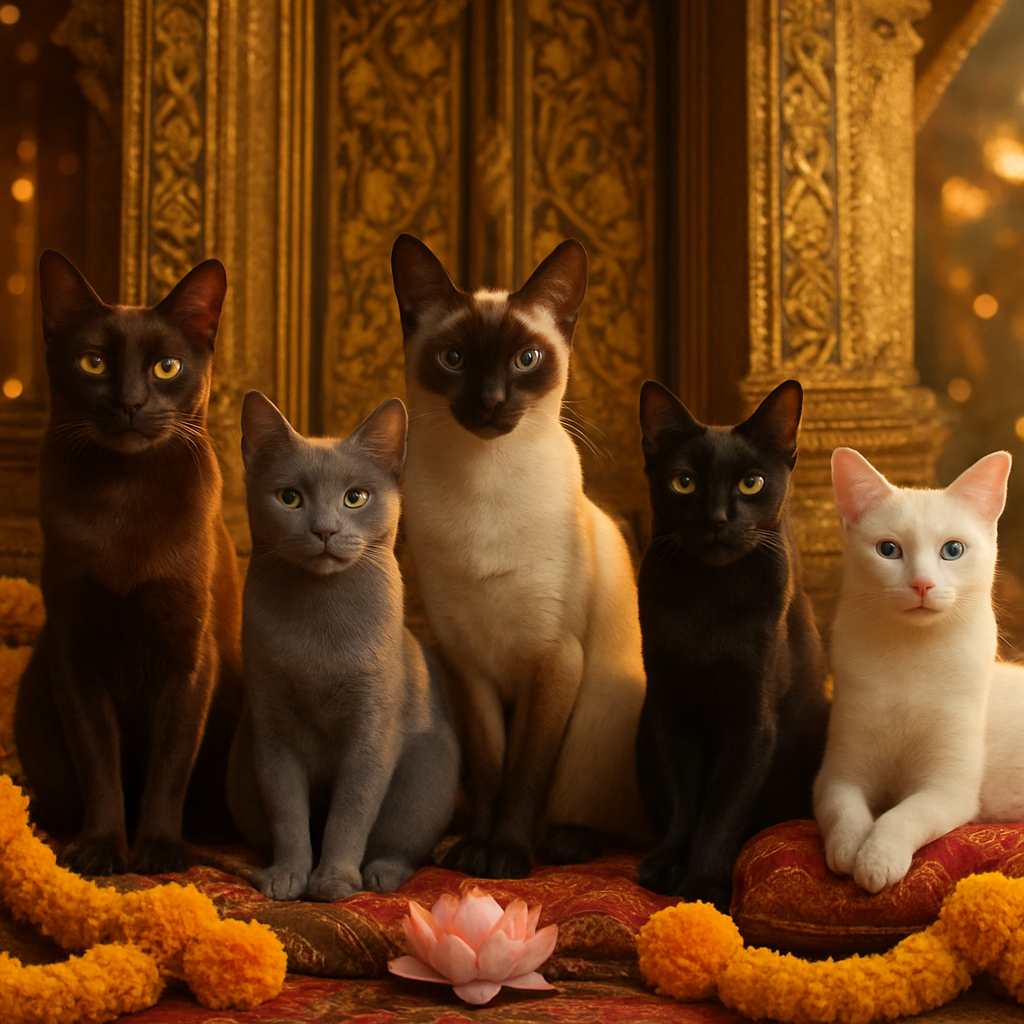Thailand just gave its native felines a very official—and very purr-fect—upgrade. The Cabinet has approved designating five native cat breeds as “national pets,” a move meant to celebrate cultural roots, protect precious genetics, and turbocharge promotion of these feline ambassadors. The announcement came from Prime Minister’s Office spokesperson Siripong Angkasakulkiat, who said the decision followed a proposal from the National Identity Committee and the National Savings Bank (NSB), both of which highlighted the deep connection between Thai cats and everyday life in Thailand.
“Thai cats have long been part of Thai culture, intertwined with local beliefs, wisdom, and daily life. They are not only beloved companions but living symbols of our heritage.” — Siripong Angkasakulkiat
That’s a high compliment for whiskers and whisker-adjacent lore. The five breeds officially recognized as national pets are the Suphalak, Korat, Siamese, Konja, and Khao Manee—each with its own look, temperament, and backstory that has charmed cat lovers at home and abroad for generations.
- Suphalak — A rich, mahogany-brown coat and a regal air; recently celebrated internationally when the World Cat Federation (WCF) recognized the Suphalak as an international breed after the 2024 WCF General Assembly in Germany, following a proposal by the Trade Association of Registered Cats (ARC).
- Korat — Sliver-blue, heart-shaped face and luck-bringing reputation; a breed long associated with good fortune in Thai tradition.
- Siamese — Perhaps the most globally famous Thai export in feline form: vocal, affectionate, and unmistakably striking with point coloration.
- Konja — Less common outside Thailand but cherished locally for unique traits and strong ties to regional lore.
- Khao Manee — White-coated and often noted for its eye colors, sometimes even heterochromia; a breed that carries mystique and elegance.
There’s a practical side to this cultural celebration. Officials say the national pet designation will help set and elevate breed standards, encourage preservation efforts to protect pure bloodlines, and push for international recognition that leaves no room for confusion—or cultural claims—from foreign breeders trying to register these native cats under other standards. The concern is more than academic: Thailand’s officials have flagged attempts by overseas breeders to reclassify or register Thai breeds abroad, which could blur provenance and cause cultural misappropriation.
By legally cementing these cats as national identity markers in the pet category, the Thai government hopes to secure rightful ownership of the breeds and to funnel that ownership into tangible economic and cultural gains. The logic is straightforward: preserved genetics and clearer standards make for better-quality breeding, which fuels tourism (people love visiting lands of legend and meeting the creatures that inspired them), and improves export credibility for responsible breeders.
“This will prevent others from claiming our native breeds and help build the creative economy through increased breeding, tourism, and export value,” officials said—an approach that treats cats not only as companions but as living cultural artifacts and soft-power tools.
The Ministry of Culture has already backed the classification, according to Amarin TV, which means government support is moving beyond symbolic declaration into practical promotion: helping breeders maintain pure lines, guiding international recognition, and weaving these breeds into cultural campaigns that extend Thailand’s soft power.
Thailand has a history of formalizing national symbols. The country previously declared the Thai elephant its national animal, the fighting fish as the national aquatic animal, the naga in the mythical-creature category, and the wai as the national greeting. Adding native cats to that roster continues a pattern of turning cultural icons into protected national identifiers—and, in this case, into living ambassadors.
The recognition of the Suphalak by the WCF last year stands out as a milestone. The WCF Thailand and ARC Facebook page shared news of the milestone after the 2024 General Assembly, signaling progress in international recognition that dovetails neatly with the Cabinet’s new designation. When breed organizations and governments move in concert, the result is often stronger protections, clearer pedigree histories, and better understanding of how to conserve genetic diversity.
For cat fans, the move is heartening: it helps ensure that these breeds won’t be diluted beyond recognition or misrepresented by others. For Thailand, it’s a clever blend of culture and commerce—an opportunity to preserve heritage while inviting the world to appreciate (and responsibly engage with) distinctive native animals.
Whether you’re a serious breeder, a traveling cat aficionado, or someone who just likes a good whisker story, the decision signals that Thailand takes its cats—and what they represent—very seriously. Expect to see more cultural programming, clearer breed registries, and maybe even cat-centered tourism experiences in the years to come. And somewhere in a quiet Thai neighborhood, a Korat might stretch, blink, and consider the national honor with distinctly feline indifference—then demand dinner.


















Good for Thailand — honoring native breeds seems respectful and smart. But I worry this will turn living animals into tourist souvenirs. Who gets to decide what a “pure” Korat really is?
Exactly, Sam — once you put a price and a passport on a cat, things get murky. Will small local breeders be squeezed out by commercial operations chasing export money?
I hope the government supports smallholders, not just big kennels. Preservation should mean community benefit, not corporate branding.
From a genetics perspective, formalizing breed standards can help, but strict ‘purity’ drives inbreeding if not carefully managed. Conservation genetics requires maintaining diversity, not narrowing it.
Tourism dollars are great, but we should demand animal welfare standards alongside promotion. Cute selfies shouldn’t replace proper care.
As a traveler I love the idea of cat-centered tourism, but this feels like cultural branding. Are cats really ‘national symbols’ or just marketing mascots?
Both, Maya. Culture and marketing often overlap; it’s fine if handled ethically. The problem is when authenticity is sold without benefit to locals.
Exactly — if revenue bypasses communities, it’s just extraction disguised as culture.
Is it extraction though? Could be soft power: cultural diplomacy that brings mutual interest and conservation funds. Depends on how it’s structured.
Breed recognition by governments can prevent misattribution, but it raises ethical questions about commodifying animals. Scientific management plans should accompany any legal designation.
Totally agree. Policy without science can do harm. Breed registries need transparent genetic screening programs and open databases to trace lineages.
Yes — and funding must support long-term breeding programs, not one-off publicity campaigns that prioritize appearance over health.
This is getting highbrow. My question is simple: will they stop people from buying Siamese in other countries? Seems impossible to enforce.
I raise cats for a living and I’m torn. Protection is good but overregulation can ruin livelihoods. Who monitors breeders and enforces standards?
As someone in Thailand, enforcement will be uneven unless national funds are allocated. Local ordinances and informal networks currently handle most breeding oversight.
So we need clear, accessible support, not just announcements. Training and subsidies for responsible breeders would help a lot.
Glad you’re in the conversation, grower134. Transparency and small-breeder representation on committees would be a good start.
Cultural appropriation angle is interesting: can a nation ‘claim’ a cat breed? It might protect heritage but also politicizes animals. I see pros and cons.
Animals can’t consent to being national symbols, but people can protect cultural ties. The risk is turning them into commodities for soft power.
In Thailand many families have these cats as neighbors, not exhibits. The move could educate people about history when done respectfully.
Education is key. If campaigns focus on heritage and welfare not profit, that’s a win.
This smells like clever branding tied to economic goals. Government backing equals better export trust, but watch for price inflation and hoarding of ‘pure’ lines.
Price inflation hurts animals too — people might breed irresponsibly to cash in, leading to genetic problems and neglect.
Which is why regulations should include welfare safeguards and penalties for malpractices, not only pedigree rules.
As a Thai cat owner, I’m proud. My Khao Manee has been part of our family for years and this honors our traditions. But I hope the spotlight doesn’t harm stray populations.
Good point about strays — governments often focus on pedigreed animals and forget community cats that need care.
We need spay/neuter programs alongside breed promotion. Otherwise tourism could worsen abandonment.
Incorporating community cat health programs would align cultural preservation with public health goals. It’s doable with multidisciplinary planning.
I’m skeptical. Nation-branding cats seems trivial when bigger issues exist. But I admit a Korat is cute and I’d love to learn about the lore.
Not trivial: culture is part of national identity. Still, resource prioritization matters, and cats shouldn’t overshadow urgent social needs.
Can we talk about enforcement abroad? If a breeder in Europe registers a ‘Korat’ variant, what stops them legally? This feels like a trademark fight over animals.
International breed registries and agreements can help, but legal frameworks differ. Diplomatic negotiation and partnerships with groups like WCF are strategic moves.
So basically it’s messy and slow. Figures.
Breed clubs in exporting countries sometimes respect origin stories if engaged properly. Outreach beats litigation most times.
As a cultural worker in Bangkok, I see potential for museums, festivals, and school programs. If funds are funneled into education, that’s positive. But watch commercialization.
Festival merchandising could be a slippery slope. Where’s the line between celebration and exploitation?
Community-led designs and profit-sharing can help set ethical boundaries. Inclusion matters.
Cultural programming should include ethics modules and animal welfare info. That would raise the national conversation.
I love the folklore attached to these cats but I’m worried about people breeding for ‘luck’ or ‘mystique’ alone. That encourages superstition over care.
Superstition can be leveraged to protect animals if directed positively. For example, cultural respect could reduce abuse if paired with education.
From a policy angle, Thailand’s move is consistent with using cultural property for soft power. The success will hinge on governance, transparency, and scientific input.
Agreed. Transparent registries, open data on pedigrees, and collaboration with international geneticists should be priorities.
We should also measure outcomes: genetic diversity indices, welfare reports, and economic benefits to communities over time.
If there are metrics and accountability, I’m more comfortable. Promises without measurement lead to hype, not conservation.